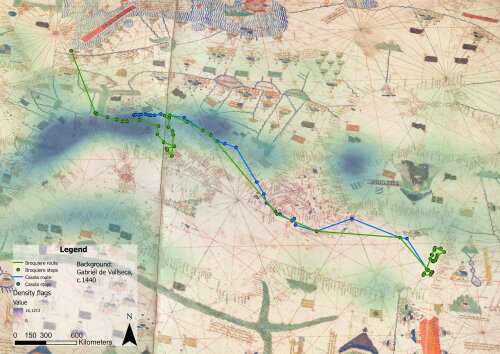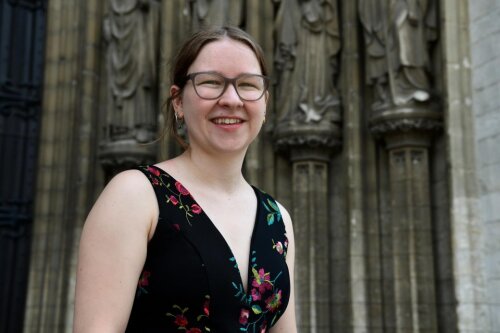Margo Buelens-Terryn
(Don’t) blame it on my Catholic upbringing and background, but let’s start with a confession: in high school, geography was one of my least favorite subjects. Besides, in a hypothetical situation where we travel together, there are better options than trusting me for the orientation or map reading skills (unless you like detours). However, I fell in love with history at a young age. My passion was only enhanced by the engaging and enthusiastic history teacher who guided me through most of my high school career. Despite my fondness, I will still prove a disappointment with history questions on a quiz: dates and names don’t necessarily stick with me. The stories, the ordinary people with their ordinary lives, stay with me – and that prompted me to study history at the University of Antwerp. (I wavered for a long time between psychology and history, finally choosing the latter because I thought I would bring the former home too much. This has already given colleagues and myself a hearty laugh; after all, we rarely leave our research at the door when coming home.)
My first love
Here’s another confession: by the end of my Bachelor’s degree, I was head over heels for nineteenth- and twentieth-century history; from a paper on the relationship between the Antwerp police and the population in the second half of the nineteenth century, a Bachelor’s thesis on noise pollution in the same temporal and geographical setting, to a Master’s thesis on a Belgian civil servant in the Congo just before and after independence, to a PhD on the lantern lecture circuit in Antwerp and Brussels in the first decades of the twentieth century. At the same time, I discovered that if you put ‘social’ in front of ‘geography’, the subject suddenly becomes interesting (gasp in Spanish).
My first introduction to GIS (Geographic Information Systems) during my Master’s year was not love at first sight: we didn’t understand each other very well. However, its usefulness for my PhD to represent the Antwerp and Brussels network of lantern lectures at different geographical levels allowed me to take more time and get to know each other better – and we soon clicked. I will not say that our relationship is perfect (which one is?) but overall, we are quite happy with and strengthen each other. My more mathematical background from high school, which had already faded by then, suddenly became a useful experience again. Starting my second year as a PhD researcher, I was given the opportunity to teach with my co-supervisor, Iason Jongepier, a module on GIS and spatial analysis to Master’s students (the same one I had struggled with two years earlier, being a student myself). Meanwhile, we are five years later and still doing this together – it’s like they say: time flies when you’re having fun.

My second love
Time flew by, and suddenly, I had to start thinking about life after my PhD. In love with history, but above all with historical research, I was not yet ready to leave academia. The 4.5 years of my doctorate represent an intense, loving, and, at times, stormy relationship with the nineteenth and twentieth centuries. While they will always have a special place in my heart, now was the time to discover if we are truly ‘meant to be’. Using the following quote to dismiss accusations of cheating is a bit controversial, but as Ross Geller from Friends would say, “We are on a break!” Time to fall in love again.
At that moment, the DiplomatiCon vacancy for a postdoc with knowledge of GIS crossed my path. At first glance, a move to DiplomatiCon may seem rather illogical or far-fetched. In retrospect, this was my ideal next step (to a subsequent, as yet unknown destination). First, I can cross the boundaries of my ability and knowledge about GIS and challenge and further develop myself in its historical applications. I now get the chance to travel even further into the past and marvel at this (for me) largely unknown period and geographical region. Again, I must confess that medievalist friends of mine had been trying to convince me for years that the Middle Ages were a catch (so let’s find out!).
During my studies, our education gradually incorporated more courses on the Islamic world. As part of the transition year, I missed some of them but came into contact with them enough to be stimulated by them. Even to such an extent that, if I had not started a PhD, there would have been a real chance that I would have gone for a second Master’s in religious studies (with a focus on interreligious contacts) (or, as I was wavering again: the Master’s in gender and diversity). Therefore, I was immediately charmed by DiplomatiCon’s approach to connected history. The Mediterranean region is the ideal testing ground for this. Lastly, coming as a PhD researcher from a group project (B-magic) and finding a new place as a postdoc in a new team only made DiplomatiCon more attractive. Being meaningful to PhD students in a way that a certain person (read: Iason Jongepier) had been to me (as a PhD student), first as a postdoc and then as a professor, was a role that strongly appealed to me. That Iason would become my co-supervisor again made me feel right at home. Malika Dekkiche, as a promoter, only strengthened this feeling.
Despite the atypical match, everything about DiplomatiCon felt right (opposites attract, don’t they?). DiplomatiCon, in other words, checked off a lot of boxes from my mental list of green flags for ‘dating historical subjects again’. My second love, therefore, doesn’t look much like my first at first sight, but it has become clear that I have a type.

I have a type
‘Behind the scenes’ supporting tasks, such as building and supporting the DiplomatiCon-net website and blog, bring me great fulfillment. Writing and doing final editing were things I already enjoyed as a student at the Antwerp student magazine dwars. Contributing ideas on translating our output to the public requires a refreshing creativity that provides some fun variety. Moreover, I love collaborating with people (and not spending time alone on my research island) and accompanying the PhD students from the University of Antwerp, Giacomo, Gianluca, and Evelina, on their journey into the wonderful (but sometimes, let’s be honest, frustrating) world of GIS combines the core elements ‘supporting’ and ‘people’. In turn, I am also very much looking forward to learning more about the Mediterranean in the (late) Middle Ages from the three of them and all the other experts on the team. This may still seem like an exciting trip into the unknown sometimes. Still, I have great confidence in my experienced guides and look forward to going on that adventure with them.
Although my time with the project will probably be the shortest compared to the other members (until February 2025), I will also develop my research within the project. Fictional stories can also tell us more about how people in the late Middle Ages viewed the relationship between the various political powers in the Mediterranean and how space was experienced. Floris and Blancefloer is one of these. I will also delve further into Middle Dutch travel narratives of travelers to the Mediterranean to better understand the sources the PhDs are working with. According to the ‘leading by example’ principle, when working with sources myself (since I am not familiar with the Italian and Spanish languages), I can explore and look out for more GIS applications.
Together with Iason, we will also monitor one of DiplomatiCon’s end goals or outputs: the delivery of a historic Gazetteer. In addition, we will also be working together to conduct our research on Portolan maps. First, we will collect, date, and georeference them and then analyze them (content-wise): which Portolan maps are related? What toponyms, symbols, and flags are depicted on them? Are these always the same cities, or does this change over time? I’m excited to explore this together.
Enough about my love life
Although the nineteenth and twentieth centuries are my first and greatest love, your first love is not necessarily (or rarely) your last. As the creators of Temptation Island would claim, sometimes you have to take the ultimate relationship test. Sometimes you need to discover other worlds before finding each other again, or to realize you’re better off as ‘just friends’. Sometimes, you fall in love all over again, and that’s how life goes. Where I end up after my interesting and challenging trip to the late-medieval Mediterranean is still unclear. Maybe I will return to my first love, or perhaps that second one will be the one I end up with; who knows. Or, as is often the best option, balancing between ‘both’ is not such a bad idea either.